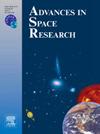Space plasma precipitation and repelling processes by field-aligned electrostatic potential in auroral arc and hole in the terrestrial polar regions
IF 2.8
3区 地球科学
Q2 ASTRONOMY & ASTROPHYSICS
引用次数: 0
Abstract
Electric fields along local magnetic field line are one of effective mechanisms for accelerating space plasmas, as represented by the cases of neutron stars and planetary auroras. In the terrestrial polar regions, anti-earthward electrostatic fields along geomagnetic field lines can accelerate electrons in space plasmas into the Earth’s upper atmosphere, generating bright and dynamic auroras characterized by arcs, curtains, curls, etc. One of the acceleration mechanisms producing “inverted V”-shaped features in energy-time/latitude distributions of precipitating auroral electrons, as observed in low-altitude space missions, is due to anti-earthward parallel electrostatic fields. The field-aligned electrostatic potentials, ranging from tens of volts to tens of kilo volts, are a consequence of the dynamo process generated in the dynamically changing magnetosphere. Our satellite instruments observed clear ion flux depletion in the energy range corresponding to localized field-aligned electrostatic potential above the satellite, which was coincidental with the electron precipitation forming the inverted-Vs. With advanced instruments onboard a microsatellite in low-altitude polar orbit, we detected recurring ion precipitation signatures accelerated by earthward parallel electrostatic fields, coinciding with electron flux depletion in the energy range smaller than the electrostatic potential. These precipitating ion signatures were observed in aurora-void regions, which we call “auroral holes” here, a conception newly defined after “coronal hole” of the Sun. These signatures provide persuasive double clues for the earthward electrostatic fields that accelerate ions toward the Earth and prevent electrons from penetrating the upper atmosphere although results in the past satellite missions might show the similar signatures.
地球极区极光弧和极光洞场向静电势的空间等离子体沉淀和排斥过程
以中子星和行星极光为代表的局地磁场线电场是加速空间等离子体的有效机制之一。在地球极地地区,沿地磁场线的反地球静电场可以加速空间等离子体中的电子进入地球高层大气,产生明亮而动态的极光,其特征为弧形、帘幕、卷形等。在低空空间任务中观测到的极光电子的能量-时间/纬度分布中产生“倒V”形特征的加速机制之一是由于反地球平行静电场。磁场排列的静电电位,范围从几十伏到几十千伏,是在动态变化的磁层中产生的发电机过程的结果。我们的卫星仪器在卫星上方的局部场对准静电势对应的能量范围内观察到明显的离子通量耗尽,这与形成倒v的电子沉淀是一致的。利用低空极轨微卫星上的先进仪器,我们检测到由地球平行静电场加速的反复离子沉淀特征,与小于静电势的能量范围内的电子通量耗尽相一致。这些沉淀离子的特征是在极光空洞区观察到的,我们称之为“极光洞”,这个概念是在太阳的“日冕洞”之后新定义的。这些特征为地球上的静电场提供了有说服力的双重线索,这些静电场加速了离子向地球的移动,并阻止了电子穿透高层大气,尽管过去的卫星任务的结果可能显示了类似的特征。
本文章由计算机程序翻译,如有差异,请以英文原文为准。
求助全文
约1分钟内获得全文
求助全文
来源期刊

Advances in Space Research
地学天文-地球科学综合
CiteScore
5.20
自引率
11.50%
发文量
800
审稿时长
5.8 months
期刊介绍:
The COSPAR publication Advances in Space Research (ASR) is an open journal covering all areas of space research including: space studies of the Earth''s surface, meteorology, climate, the Earth-Moon system, planets and small bodies of the solar system, upper atmospheres, ionospheres and magnetospheres of the Earth and planets including reference atmospheres, space plasmas in the solar system, astrophysics from space, materials sciences in space, fundamental physics in space, space debris, space weather, Earth observations of space phenomena, etc.
NB: Please note that manuscripts related to life sciences as related to space are no more accepted for submission to Advances in Space Research. Such manuscripts should now be submitted to the new COSPAR Journal Life Sciences in Space Research (LSSR).
All submissions are reviewed by two scientists in the field. COSPAR is an interdisciplinary scientific organization concerned with the progress of space research on an international scale. Operating under the rules of ICSU, COSPAR ignores political considerations and considers all questions solely from the scientific viewpoint.
 求助内容:
求助内容: 应助结果提醒方式:
应助结果提醒方式:


